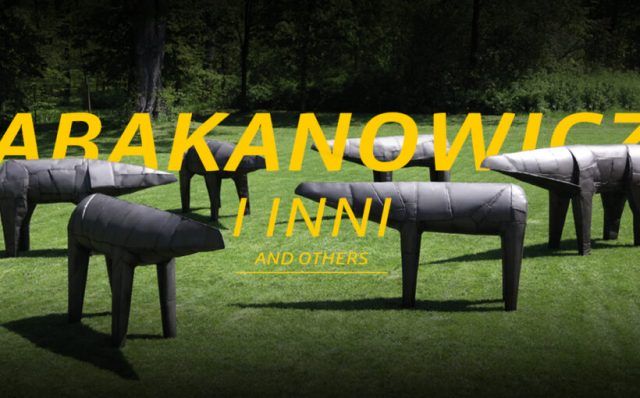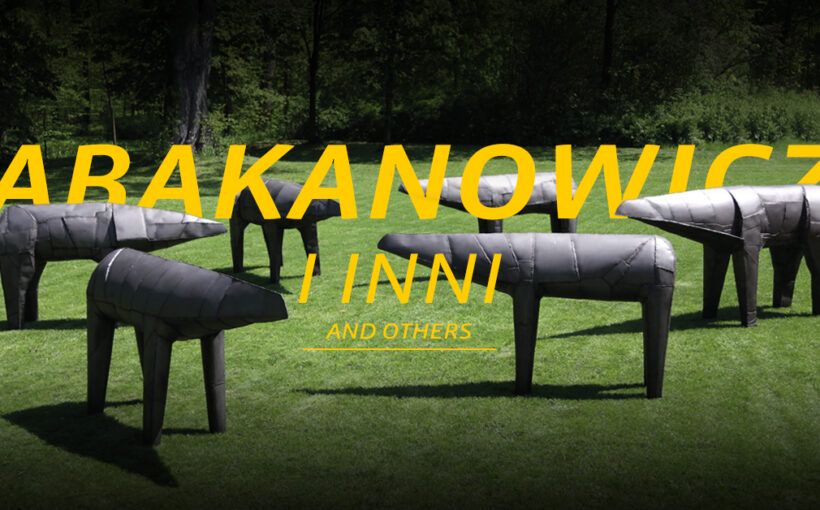
Abakanowicz and others
Sculptures from the collection of the Centre of Polish Sculpture in Orońsko
The exhibition Abakanowicz and Others presents the works of the following artists: Magdalena Abakanowicz, Paweł Althamer, Sylwester Ambroziak, Mirosław Bałka, Krzysztof M. Bednarski, Leszek Golec / Tatiana Czekalska, Kijewski / Kocur, Grzegorz Klaman, Piotr Kurka, Józef Łukomski, Krzysztof Markowski, Dorota Nieznalska, Robert Rumas
Curator: Krzysztof Stanisławski
Collaboration: Dr Jarosław Pajek
Coordinator: Renata Sargalska
Production: Wojciech Ruminski
Centre of Contemporary Art Znaki Czasu in Torun
Magdalena Abakanowicz is an icon of Polish contemporary art, an artist of the highest international renown since the 1960s till now. She gained fame and recognition as a weaver, author of the seminal ‘abakans’ which transformed the world fibre art, bringing it close to sculpture. And this is the way – towards classical sculpture – that Abakanowicz followed for the successive decades. Grand Prix of Biennale São Paulo and participation in almost all major international biennials in the world consolidated her position of the most recognized Polish artist. Her success with the public and critics was followed by her success in the art market. Magdalena Abakanowicz collaborated with the famous Marlborough Gallery in London and New York as well as other prestigious galleries, which resulted in many purchases and public commissions. Today her works can be found in the collections of key art museums in the world, including the MoMA in New York, and groups of her works adorn among others Agora Park in Chicago as well as Cytadela Park in Poznan. Abakanowicz did not forget about Poland – one of the best collection of her works is owned by the National Museum in Wrocław and also by the Centre of Sculpture in Orońsko. It is from that collection that Mutants, presented in this exhibition, come from.
However, Polish contemporary sculpture – at the highest artistic level, universal, rich and diverse, well-known in Poland and abroad – is not limited to the work of Magdalena Abakanowicz. Indeed, it is a certain model and point of reference, especially when we consider international significance, but at least since the 70s, and broader in the 80s, a group of highly original and very reputable younger artists appeared. They were developing the threads once touched upon by Abakanowicz, such as reflections about the human condition, our bonds with the world of animals and nature, but they also went in other directions: towards social, political problems which were closer to them and the audience of their works.
The exhibition at the CSW presents Magdalena Abakanowicz’s classical sculptures, in the company of works made by artists, like e.g. Józef Łukomski, who undertook similar themes and used a comparable sculptural technique but due to various circumstances were not able to develop their career, now remaining in oblivion. Undeservedly, so now with even greater joy we can remind their work, drawing from the rich holdings of the Orońsko collection.
However, the richest part of the exhibition presents artist who made their debuts in the dramatic period of the 80s, starting from the euphoria of August 1980 and the Solidarity movement, brutally stifled by the introduction of martial law and a deep economic crisis. Later, in the 90s, these artists tried their hand in the new reality of predatory capitalism and did quite well.
The 80s proved particularly successful for artistic groups, such as Neue Bieriemiennost with Mirosław Bałka (we show one of his lesser known works from the CRP collection), Mirosław Filonik and Marek Kijewski. The works of the latter, in the tandem Kijewski/Kocur constitute an important part of the exhibition due to their ephemeral form and message. Other significant works were created by the representative of the other major sculptural group of the 80s – Koło Klipsa from Poznan, with Krzysztof Markowski, and an installation by Piotr Kurka, connected with Koło Klipsa. Markowski’s boat may be treated as a symbol of art of the 80s, which was unable to reach international audience as a result of the martial law restrictions.
The panorama of the achievements of the New expression – such was the name given to the independent art of the 80s in Poland – is complemented by the work of two artists who chose a separate path, outside any groups. These are: Grzegorz Klaman from Gdansk, whose two large works from different periods of activity are present at the CSW, and Krzysztof M. Bednarski from Warsaw and Rome. We are very lucky to be showing his Sphinx Made from Matchboxes, a good rationed during the martial law, familiar from the exhibition Expression of the 80s at the BWA in Sopot (1986), which was one of the first manifestations of the New expression. Both Klaman and Bednarski were actively developing their work in the 90s, when the so-called critical art appeared. They are also active in the first decades of the 21st century. We are also showing a miniature sculpture by Paweł Althamer, one of the outstanding figures of critical art, as well as works of artists who originally developed the ideas of artistic criticism – Robert Rumas, Dorota Nieznalska and the duo Leszek Golec + Tatiana Czekalska.
Abakanowicz and Others is an exhibition without a theme, thesis or diagnosis bonding all the works – it is an exhibition of wonderful sculptures, universal artworks appealing to the viewers first and foremost with their artistic values and profoundly humanistic subject matter. This is a panorama of Polish contemporary sculpture, in a set coming from one of the most important collections in Poland – from the Centre of Polish Sculpture in Orońsko, this year celebrating its 40th anniversary.
